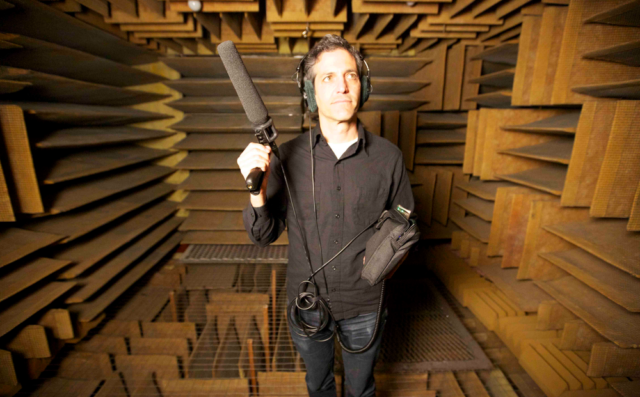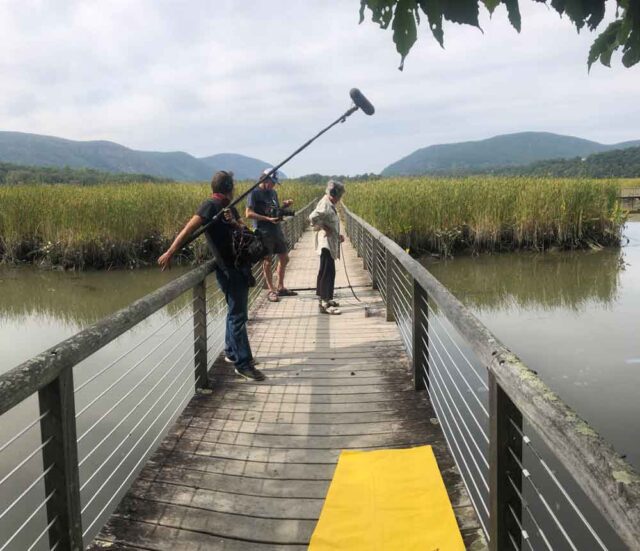
Sam Green explores how we listen and connect with humanity and nature in 32 Sounds
32 SOUNDS (Sam Green, 2022)
Film Forum
209 West Houston St.
Opens Friday, April 28
212-727-8110
filmforum.org
32sounds.com
Sam Green’s 32 Sounds might be about how we hear the world, but it’s also filled with a barrage of stunning visuals that, combined with the binaural audio, creates a unique and exciting cinematic journey.
Green was inspired by his relatively new friendship with experimental composer and musician Annea Lockwood, which blossomed over Skype during the pandemic, and by François Girard’s 1993 biographical anthology Thirty Two Short Films About Glenn Gould, in which Colm Feore portrays the Canadian classical pianist most famous for his interpretations of such Bach works as the Goldberg Variations. In 32 Sounds, Green teams with composer, DJ, and musician JD Samson, from such bands as Le Tigre and MEN, to present ninety-five minutes of remarkable delicacy and insight.
The film is best experienced on headphones; at Film Forum, where it opens April 28, it will be shown several different ways, including with specially customized headphones with the audio mixed live inside the theater. The sound was recorded binaurally, so the audience can hear speech and movement as if it’s to your left or right, behind you, far away, or close up.
In the film, Princeton professor and scientist Edgar Choueiri introduces us to Johann Christoff, a recording device shaped like a human head that “captures sound exactly how you hear it.” Similar technology has been used for such theatrical presentations as The Encounter and Blindness. Hollywood veteran and two-time Oscar winner Mark Mangini (Dune, Mad Max: Fury Road) designed the sound for the film, immersing the viewer into what feels like a three-dimensional universe.
The film kicks off with Green and Samson in a playful scene that sets the stage for what is to follow. “This is a little bit of an odd movie in that we’re going to ask you to do some things,” Green explains. “Simple things, like close your eyes. If you don’t want to do them, don’t worry about it. But the truth is, the more you give yourself to the experience” — Samson then cuts in, finishing, “the more you get out of it.”
The first sound Green explores, appropriately enough, is of the womb, recorded by former midwife Aggie Murch, whose husband is Oscar-winning film editor and sound designer Walter Murch (Apocalypse Now, The English Patient, The Conversation). Over a purplish white screen with no figuration, Green discusses Walter Murch’s 2005 essay “Womb Tone,” in which Murch writes, “Hearing is the first of our senses to be switched on. . . . Although our mature consciousness may be betrothed to sight, it was suckled by sound, and if we are looking for the source of sound’s ability — in all its forms — to move us more deeply than the other senses and occasionally give us a mysterious feeling of connectedness to the universe, this primal intimacy is a good place to begin.”
Green then jumps from birth to death, taking out old cassette tapes of voice messages he has saved from decades past, telling us how “they hold the voices of so many people I’ve loved who are gone. I was wondering, How does that work? How does a little piece of eighth-of-an-inch magnetic tape hold a person? Make it seem like they are alive and in front of you more than any photo or piece of film ever could. I was wondering if sound is somehow a way to understand time, and time passing, and loss, and the ephemeral beauty of the present moment, all the things that I keep coming back to in my movies.”
He meets with Cheryl Tipp, curator of Wildlife and Environmental Sounds at the British Library Sound Archive, who shares the poignant and heartbreaking story of the mating call of the Hawaiian bird the moho braccatus. Lockwood, the subject of a short companion film Green directed, demonstrates how she has recorded the sound of rivers for fifty years, after gaining notoriety for her burning-piano installations.
Foley artist Joanna Fang reveals how she creates sound effects for films using unusual items in her studio, from a bowling ball to a wet cloth. “Art can elevate a truth beyond what is feasibly there,” she says. “And if we pull it off right, hopefully the emotional experience of hearing it and being part of it is enough to make you fully accept the poetry of what you’re hearing. Because isn’t that what we’re all trying to do, trying to take what we’re feeling on the inside and show it to somebody else, or let them listen to it, and have them feel the same way we do?”
Black revolutionary and fugitive Nehanda Abiodun listens to a tape of McFadden & Whitehead’s “Ain’t No Stopping Us Now,” transporting her to another place and time. Poet and cultural theorist Fred Moten marvels about “ghost sounds” of his relatives. Bay Area military veteran and environmental journalist Harold Gilliam postulates about sleep and foghorns in the context of “being part of this total community of life and nonlife on Earth.” Lebanese artist and musician Mazen Kerbaj recalls being able to make sound art during bombings when others were trapped in their homes or dying.
Green gives examples of recording “room tones,” a documentary process in which the subject is silent for thirty seconds as the sound recordist grabs the natural sound in order to help with later editing. It’s fascinating watching Philip Glass, Laurie Anderson, Rebecca Solnit, and others sit or stand uncomfortably as they wait, and we wait; we are not used to seeing such stagnation in a motion picture.

Annea Lockwood has been recording rivers for more than fifty years
Deaf sound artist Christine Sun Kim uses ASL to describe vibration and how she was taught when she was a child that sound was not part of her life, a concept that infuses her art. “I realized that sound is like money, power, control; it’s social currency,” she explains.
Along the way Green also looks at inventor Thomas Edison, polymath Charles Babbage, electronics engineer Alan Blumlein, and a classic Memorex commercial starring Ella Fitzgerald. We see and hear Glass playing piano, church bells ringing in Venice, Don Garcia driving through the city in his red Mazda blasting Phil Collins’s “In the Air Tonight,” and John Cage performing 4’33” outdoors. A Zamboni cleans the ice at a hockey rink. A cat purrs. Evel Knievel jumps over obstacles on his motorcycle. Samson blasts away on a whoopee cushion. Danny drives his Big Wheel through the empty halls of the Overlook Hotel in The Shining. Different groups dance to Donna Summer’s “I Feel Love.”
Oscar nominee Green (The Weather Underground, A Thousand Thoughts) edited the documentary with Nels Bangerter; the new, sharp cinematography is by Yoni Brook. The visuals range from a deluge of quick cuts of archival footage to nearly blank screens when Green asks the audience to close their eyes and just listen.
While the film is a technical marvel, it also becomes deeply emotional, as Green and several subjects listen to recordings of friends and family no longer with us, something you can’t get out of a photo album. It made me think of the messages I had saved on my answering machine of my mother, who passed away in 2017; while I try to avoid hearing them — they used to pop up after I went through new messages, sending me screaming into another room — it is comforting to know that they exist, that I can hear her whenever I need to. Such is the power of sound.
Green will be at Film Forum for postscreening Q&As with Lockwood, moderated by Nadia Sirota, on April 28 at 7:40, with Choueiri and Anderson on April 29 at 7:40, and with Samson, moderated by Matt Wolf, on April 30 at 5:15.